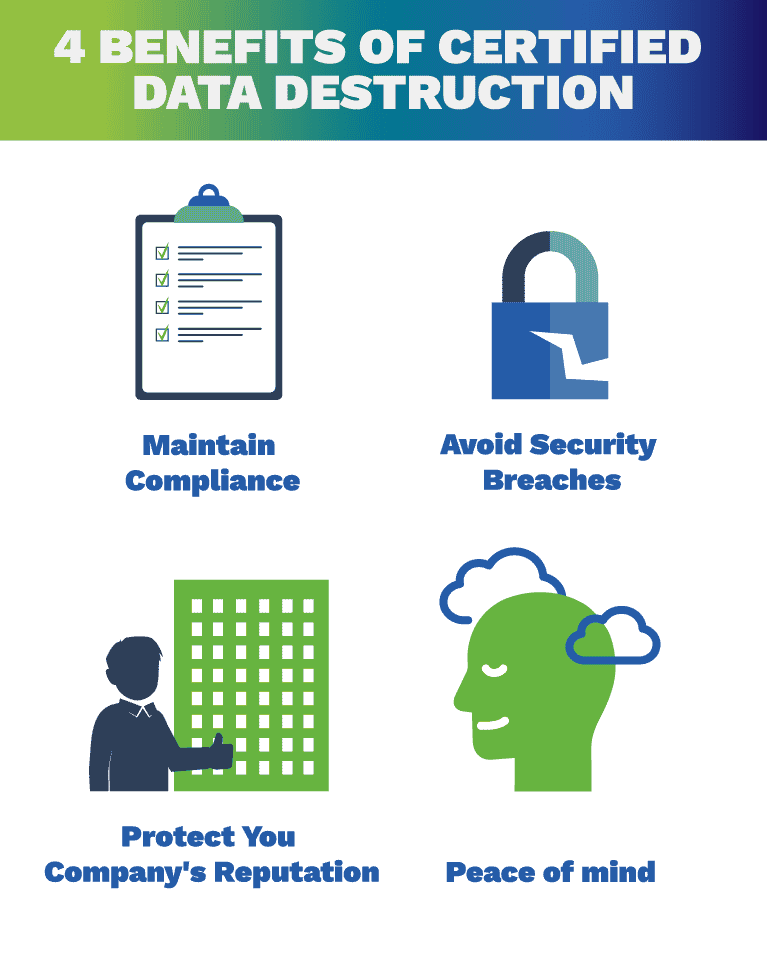Maximizing Cyber Security through Advanced Data Destruction Techniques
Maximizing Cyber Security through Advanced Data Destruction Techniques
Blog Article
The Relevance of Effective Information Destruction Practices in Shielding Sensitive Information and Ensuring Computer System Safety And Security
In a period where information violations are significantly common, the importance of effective data destruction practices can not be overstated. Organizations face significant threats when sensitive information is improperly thrown away, possibly resulting in unauthorized gain access to and serious financial consequences. Applying robust information damage techniques not only alleviates these risks but likewise straightens with lawful compliance requirements, ensuring that organizations support their online reputation and foster customer depend on. The inquiry continues to be: what specific approaches can be used to improve these techniques, and how can companies successfully integrate them right into their general cybersecurity framework?
Recognizing Data Destruction
Understanding information devastation is crucial in today's electronic landscape, where delicate details can easily be jeopardized. Reliable data damage includes not just making certain yet removing data that data is irretrievable through thorough methods. This process is crucial for organizations that take care of confidential customer information, intellectual residential property, or inner records, as any type of breach can cause serious monetary and reputational consequences.
Information devastation includes various techniques, consisting of shredding physical media, degaussing magnetic storage tools, and employing software-based services that overwrite data several times. Each method offers a certain purpose and needs to line up with the level of sensitivity of the info being disposed of. For instance, physical destruction is frequently chosen for hard disk drives including very personal data, while software techniques may suffice for much less sensitive info.
Furthermore, adhering to sector requirements and regulations, such as the General Data Security Regulation (GDPR) or the Medical Insurance Transportability and Responsibility Act (HIPAA), is essential for compliance and to minimize lawful threats. Organizations must establish a robust information devastation policy, train workers on finest methods, and regularly audit their procedures to make sure that all delicate info is dealt with securely and effectively.
Dangers of Inadequate Practices
Insufficient information devastation methods subject companies to substantial threats that can have significant repercussions. When sensitive info is not effectively gotten rid of, it continues to be prone to unapproved gain access to, which can cause information violations and identity theft. Such events not only jeopardize the safety and security of people but additionally taint the company's credibility, resulting in a loss of customer trust fund and prospective financial consequences.
Furthermore, governing compliance is significantly rigid in lots of industries. Failing to follow data damage policies can result in hefty penalties and lawsuits against companies. These charges can divert and stress economic sources focus from core business operations.
Furthermore, the abuse of recurring data can lead to intellectual property theft or corporate reconnaissance, threatening affordable advantages (data destruction). The impact of poor data devastation extends past instant monetary losses; it can also lead to lasting damage to brand name integrity and market position

Organizations must identify that data security is not solely about avoiding violations; it likewise includes the accountable administration of information throughout its lifecycle. Overlooking efficient data destruction methods can have disastrous effects, underscoring the need for durable procedures to reduce these threats.
Best Practices for Information Damage
Applying efficient data devastation techniques is go to these guys crucial for guarding sensitive information and preserving conformity with regulative standards. Organizations should adopt a multi-faceted approach to ensure that information is irretrievable, thereby avoiding unapproved access and prospective violations.
First, data need to be categorized based on sensitivity, allowing organizations to apply ideal destruction approaches tailored to the degree of danger. For digital data, utilizing software-based data-wiping tools that follow sector requirements can properly overwrite existing information. Physical destruction methods, such as shredding or degaussing, are crucial for tools that keep delicate details, ensuring complete removal.
Establishing a clear data retention policy is important, outlining for how long various kinds of info need to be retained before damage. Routine audits of data storage space systems are additionally necessary to recognize obsolete or unneeded data needing elimination.
Moreover, training staff members on the relevance of data damage and the certain methods to comply with fosters a society of protection within the organization. Preserving documentation of data devastation refines supplies liability and supports compliance with external regulations and interior policies. By sticking to these finest techniques, companies can substantially mitigate the risks linked with information exposure.
Legal and Conformity Factors To Consider

Failing to abide by these regulations can lead to extreme penalties, including substantial penalties and reputational damage. Organizations should carry out a durable data damage plan that straightens with these lawful frameworks and provides clear standards on the proper techniques of information disposal, whether physical shredding or electronic cleaning.
In addition, preserving documents of information devastation activities is important for showing conformity during audits or inspections. By focusing on legal and conformity considerations, organizations can enhance their data safety position and foster trust fund with stakeholders and clients, eventually contributing to an extra safe data monitoring atmosphere.
Benefits of Effective Information Destruction
Effective information devastation methods extend past simple compliance; they use substantial benefits to companies that prioritize them. By guaranteeing that delicate information is irretrievably destroyed, companies minimize the danger of information breaches and the potential economic consequences connected with them. This aggressive method not only safeguards against unauthorized accessibility however also improves the total trustworthiness of the company in the eyes of clients and stakeholders.
Implementing durable data damage techniques, such as physical damage of storage gadgets use this link or sophisticated data wiping strategies, contributes to the conditioning of an organization's cybersecurity posture. data destruction. It minimizes the probability of copyright theft and shields exclusive information, thereby maintaining an affordable edge in the market
Conclusion
To conclude, effective data damage practices are essential for safeguarding delicate details and boosting total computer protection. By executing detailed approaches such as software program, shredding, and degaussing overwriting, organizations can mitigate the threats associated with unauthorized access and data breaches. Adherence to regulatory standards, consisting of GDPR and HIPAA, more enhances compliance and protects against lawful effects. Ultimately, a commitment to durable data destruction strategies cultivates a society of responsibility, thus reinforcing an organization's cybersecurity posture and maintaining customer count on.

Report this page